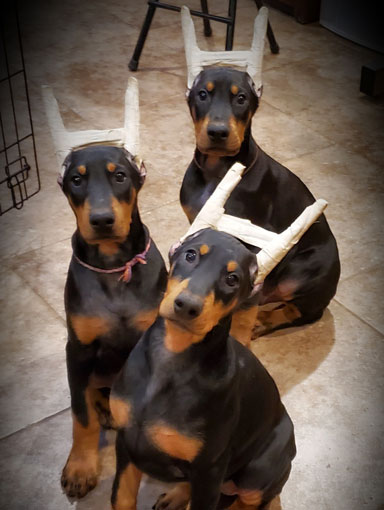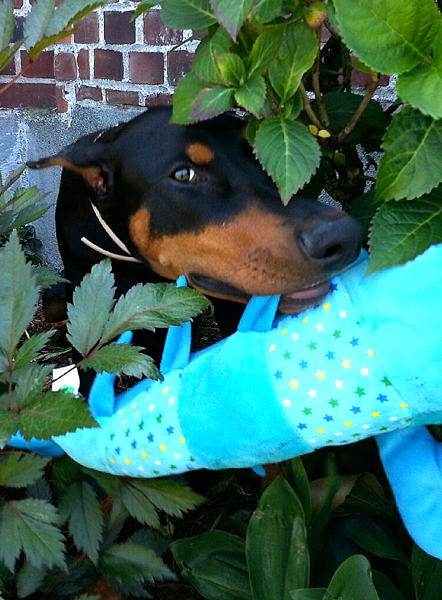Resources
We love helping people get to know this wonderful breed and learning ways to enjoy their new family member.
Here is a list of useful sites for more in-depth information on the Doberman breed as well as finding more reputable, ethical breeders.
- Doberman Pinscher Club of America provides in-depth resources including history and breeder referrals.
- The American Kennel Club offers useful information on everything from dog care to dog sports
- The Puget Sound Doberman Pinscher Club is a great local resource for Western Washington.
- The Mount Hood Doberman Pinscher Club covers the Western Oregon area.
- British Columbia Doberman Pinscher Club is in Western Canada
If you are interested in a senior or special needs dog, these organizations may help
- Seattle Purebred Dog Rescue Doberman Page offers great information on the breed and a good “pros/cons” list
- Seattle area Doberman Rescue Facebook page
- Special Needs Dobermans
- The Senior Doberman Project

Ear Posting Tips
For Dobermans, Great Danes and Boxers
Supplies you’ll need:
- 1/2″ backer rod (5/8″ Danes)
- Wooden stir sticks or skewers
- Q-tips
- Cotton balls
- Johnson & Johnson Zonas tape
- A blade to slit backer rod foam
I make the backer rod stiffer by slitting it halfway through with a blade, then placing a stir-stick or something like that in the middle. I then tape the white tape down & then back tape. I put a small piece of cotton on the end going into the ear canal with an antibiotic ointment.
I place the cotton end into the ear canal, pull the ear leather fairly taught & start my tape at the top of the ear to keep the stretch on the leather. I use Johnson & Johnson zonas porous tape. Next piece of tape is at the base, then I finish off covering the ear leather with tape. Apply constant even light pressure, taping inward to the top skull, then squeeze the tape on as well.
I also always do a bridge to support the ears & the weight of the posts on the top skull muscle (bridge is made by 3 Q-tips taped together). Not putting on a bridge causes the top skull muscle to stretch — you don’t want that muscle memory. You want it high & tight, making ears like like Batman!

Showing and Training Tips
Dobermans are busy dogs. They love to work and they NEED a job to do — if you don’t provide them with one, they’ll find something to do on their own (and you might not like the results!)
In the Seattle metropolitan area:
- Gold Star Dog Training offers training in Auburn & Enumclaw (King County), ranging from competition obedience to family dog basics.
- Heather O’Neill offers agility coaching and classes in Auburn, from puppy foundation to world-team competition skills.
- In Arlington (Snohomish County), Kristi Crabtree offers motivational dog training
- Kim has trained and handled many of the Ravensown KO dogs to Champion and beyond, learn more about our handling services.
Online resources:
- The DPCA has a good page on obedience/training articles for the Doberman pinscher
- There’s also a page on understanding and getting started in conformation (many written by our co-breeder Michelle Santana!)
- If your child is interested in learning about dogs, 4-H is a terrific start and will help them learn to be Junior Handlers. Search for your local 4-H extension and contact them.
- Pure Dog Talk the voice of purebred dogs, offering tips and tools to have an awesome life with your purebred dog
- CogDog Radio by Sarah Stremming, focused on agility and dog behavior.
- Fenzi Dog Sports Academy offers extensive online courses, webinars and workshops
Terms to Know
Purpose-Bred Dogs
Purpose-bred dogs perform a specific job, from hunting game to herding livestock to working in service to a person with disabilities, having the inborn qualities needed to succeed.
Dog breeds truly became “breeds,” because of the specific skill sets they offered to improve humans’ lives. Chihuahuas were used to keep tarantulas out of the houses in Mexico. Basset or “low” hounds flushed waterfowl in French swamps where their long ears literally retained the scent. Salukis are an ancient breed used by the Bedouins to run down food in the Arabian desert. Herding dogs nip the heels of calves, to communicate a get-back-over-there message. Guard dogs — like Dobermans — are canine sentries and alert protectors.
Purpose breeding demonstrates both the longevity and depth of our partnerships with dogs.
Many “-doodle” or “designer” dogs have been bred only for profit and to cash in on the catchy “-doodle” type names. While all dogs deserve a good home, and the majority of non-purebreds are good dogs, too many of the “designer” dogs are plagued by mental or physical problems which can be quite expensive and heartbreaking. This is the reason why we talk about the predictability of a purpose-bred dog.
Rescue Dogs vs Rescue-Bred Dogs
A rescue dog is a dog that has been placed in a new home after being abused, neglected, or abandoned by its previous owner. Animal rescue organizations exist to rescue, protect, care and re-home dogs from unnecessary euthanasia.
Many dogs need help and are abandoned through no fault of their own. However, be cautious about where these dogs came from — know that someone bred the bitch, whelped the pups, raised the litter and they are now being called “rescue” dogs. Be sure you are not supporting puppy mills or backyard breeders or unethical organizations who produce animals for profit and sell them as “rescue” dogs.
Puppy Mills
This is a commercial dog breeding facility that breeds dogs for profit. We associate this practice with filthy inhumane conditions which is what a lot of puppy mills are, but you may not realize that many clean and well kept “kennels” are actually “puppy mills.” This is when there are many dogs, many litters, and sometimes many different breeds. There is little to no commitment and limited knowledge from the breeder. Depending on the price charged, these dogs could be very cheap or very expensive. The risk for future heartbreak (behavioral and health conditions, early death) and breaking your bank (vet bills) are high. Please do not support this practice.
Backyard Breeders
This does not mean they literally breed or raise dogs in the backyard, but that they breed with little knowledge or qualifications for their program. If they are breeding for pets, for money, for a fun experience, etc they are practicing “backyard breeding.” Although many BYB’s are well-intentioned, the risk for future behavioral and health conditions, early death and genetic health issues are highly likely because they are breeding without an actual knowledge of pedigree’s health and longevity.
Reputable Breeders
These types of breeders are incredibly dedicated and committed to the breed, to the dogs they produce, and to the owners of their puppies. They use the breed’s written standard as a blueprint for what they produce. They are knowledgeable and willing to share that information with you. They are involved in show/working/breed appropriate venues because this is where we learn more and have our dog’s structure/temperament/abilities qualified for possible future breeding.
Their dogs are fully health tested and of appropriate age and condition to be bed. They carefully interview prospective buyers and a contract is provided for each puppy along with spay/neuter requirements and limited registration for pet homes. These dogs may cost more but because the breeder has invested so much into the quality of the breeding dogs and the quality and longevity in the bloodlines, is so dedicated in raising them well in the first critical 8+ weeks, and they follow up with you for life, then it is very likely to have a healthy happy experience.
Ear crop
The proper and ethical method of cropping is done by a licensed, skilled, and experienced veterinarian. The ideal age for a Doberman is 7-9 weeks of age, before the ear cartilage begins hardening. They are fully sedated (anesthetized) and the edges are stitched up and remain in a “cup” on the pup’s head for ten days. The stitches are removed at about a week and the cup comes off at about two weeks. Not any part of this process is cruel or painful!
After the cup comes off, they will need to be “posted” for several weeks or months depending on the dog and the style of crop for how long it may take. They don’t automatically stand straight up but the “posting” is the necessary after care where the ears are gently taped into position and in time the cartilage hardens upright. The cropped ear still has mobility and you will see them flattening them or perking them to the right or left. The posting process is critical to ensure the crop is successful. Click here to see my videos on posting ears.
Tail dock
The age for docking (and dewclaw removal) is between 3-5 days old and puppies are not picked out until 8 weeks old, so all our puppies will have tails docked and dewclaws removed.
Volhard Puppy Aptitude Test
Many tests have been developed on puppies, particularly for Guide Dogs. The most well-known one is the Volhard:
1. Social Attraction – degree of social attraction to people, confidence or dependence.
2. Following – willingness to follow a person.
3. Restraint – degree of dominant or submissive tendency, and ease of handling in difficult situations.
4. Social Dominance – degree of acceptance of social dominance by a person.
5. Elevation – degree of accepting dominance while in a position of no control, such as at the veterinarian or groomer.
6. Retrieving – degree of willingness to do something for you. Together with Social Attraction and Following a key indicator for ease or difficulty in training.
7. Touch Sensitivity – degree of sensitivity to touch and a key indicator to the type of training equipment required.
8. Sound Sensitivity – degree of sensitivity to sound, such as loud noises or thunderstorms.
9. Sight Sensitivity – degree of response to a moving object, such as chasing bicycles, children or squirrels.
10. Stability – degree of startle response to a strange object.


